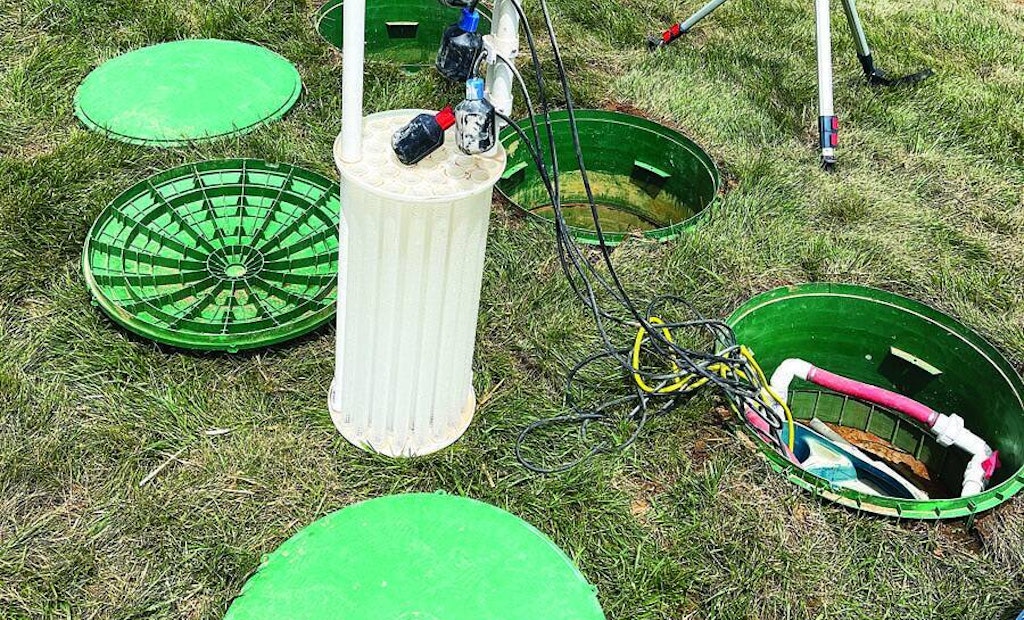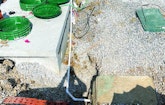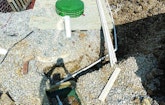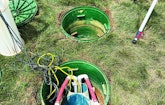
With landscaping in place, the Orenco Biotube filter assembly with its pump and floats is ready for installation in the pumping section of the two-chambered tank. (Photos courtesy Michael Davenport)
Interested in Septic Tanks?
Get Septic Tanks articles, news and videos right in your inbox! Sign up now.
Septic Tanks + Get AlertsThe job in an urban area wasn’t typical for an onsite installer, but it was also intended to help the city of Chattanooga, Tennessee, deal with treatment capacity issues.
“Our wastewater treatment plant is overloaded as it is,” says Michael Davenport, owner of Poop Dudes in Chattanooga. The problem is stormwater infiltration, he adds.
To ease the load on the wastewater plant, the city hired subcontractors to install septic tank effluent pumping, or STEP, systems for new-housing tracts and a few existing homes that had been on septic and where city sewer was available. Reducing the strength of wastewater and using the septic tanks to equalize flow means less demand on the city’s plant.
In East Brainerd, an unincorporated area of large homes about 15 miles east of downtown Chattanooga and on the city’s border, systems were set at single-family homes. In another neighborhood, on Lookout Mountain above the city to the south, buildings receiving onsite systems are town homes intended for senior citizens.
Simple STEP
The STEP system is simple.
Water comes out of each home in a 4-inch PVC pipe and runs 5 to 7 feet to a tank. Single family homes in East Brainerd received 1,500-gallon tanks. Town homes on Lookout Mountain received 2,000-gallon tanks.
All of the tanks are two-chamber concrete from Bradley Tank & Pipe in Cleveland, Tennessee. Inside each is an Orenco pump with a filter on its bottom. It’s a neat item, but pulling pumps completely to clean filters could become a chore, Davenport says.
County specs call for a 24-inch riser (TUF-TITE, Inc.) over the pump chamber, a 10-inch inspection port above the outlet tee from the first chamber into the second, and a 6-inch inspection port over the inlet tee. Floats control the pump timing.
For the first year after installation, Poop Dudes is responsible for maintenance. After that, the county water and wastewater authority will take over pump maintenance, Davenport says. Residents will still be responsible for having their tank pumped.
Cost of the STEP systems is built into the price of the homes.
Total contract was for slightly more than 100 systems. Jobs were done as need arose. Homes are built and typically sell in a week, he says.
For the job Davenport used a 2021 Bobcat E32 mini-excavator and a 2016 Bobcat E50 excavator.
Tough rules
From a work standpoint, the jobs went smoothly. Davenport’s team pushed out three systems per week when they started the contract, then settled into a routine of about one a week. Systems were done as homes in the development were sold, which left the company time for its other work: repairs, sewer lines, and site work in Nashville and Knoxville for Zaxby’s, a regional restaurant chain.
The problem was the rigidity of the project rules.
“They’ve had trouble in Chattanooga finding contractors who would take on this job,” Davenport says. At first he also refused the work. Davenport’s company does septic work outside the city, but does quite a bit of drain cleaning in the urban area.
The company that took the bid eventually called Davenport and asked if he would take over as a subcontractor.
“It became a real nightmare for everybody involved,” he says.
“We’re talking about these tiny, cookie-cutter lots already. We’re setting these huge 1,500-gallon tanks in a front yard,” Davenport says. “We’re putting these septic tank effluent pumps in places where they’re pumping downhill.”
To make the job easier, Davenport suggested rotating the tanks 90 degrees. Original specifications called for them to be set less than 5 feet from utilities buried in the yard, which was against other rules.
Half the East Brainerd neighborhood is on municipal sewer, and the other half has municipal sewer plus STEP systems.
Each job had to be inspected by Hamilton County upon completion. Sometimes that took an hour, sometimes two days, Davenport says.
Working on Lookout Mountain brought a different challenge. Lots there had about 2 feet of soil on top of sandstone. A hydraulic hammer on the mini-excavator created holes for the tanks. One hole took about eight hours of hammering.
“Sometimes we subbed the hammering out. That way we didn’t tie up both of our machines on the same job,” Davenport says.
About three-fourths of the systems were installed in East Brainerd, with the rest on Lookout Mountain. Installations began in 2020 and were scheduled to finish in 2022.
Soil in East Brainerd was backfill that had been compacted. Before the neighborhood was created, the area was a wetland, Davenport says. Builders put in 40 to 50 feet of fill as a base for the houses and created wetland elsewhere to compensate for the loss of wetlands habitat.
“And you can tell it’s fill because the soil will change every couple feet. You’ll get some darker clayish soil and then it’ll be more like chert,” he says.
“The building contractor is doing all the backfilling for us, so we don’t even have to use a skid-steer,” Davenport says. Backfilling just means topsoil, he adds. His crew did the initial backfill to make sure the pipes were correctly bedded.
Another challenge in East Brainerd was piling dirt. Most of the time it was stored on driveways. The building contractor had a trucking company haul the excavated dirt away for use as fill somewhere else, he says.











